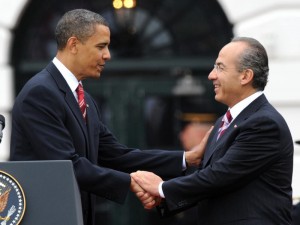Obama and Calderón cement conservative alliance during state visit
President Barack Obama rolled out the red carpet for Mexican president Felipe Calderón last week, in a highly scripted state visit that included neighborly platitudes, a speech to Congress and a lavish state dinner.
The political back-patting between two presidents who face stiff internal opposition was designed mainly to boost domestic ratings. Obama sought a stage to promote his commitment to comprehensive immigration reform, amid criticism from Latino voters for his lack of action and the increase in repressive measures against immigrants.
Calderón faces a crisis of confidence in his country as his signature war on drugs has driven up the drug-related murder rate and shows no signs of permanently weakening organized crime.
The photo ops and the declarations of binational amity seemed to go smoothly. If the words and events of the visit were all one knew about these two countries, it could be easy to believe the rhetoric that the U.S. and Mexican governments are bravely taking on the tough problems and moving toward joint solutions.
But it doesn’t take too many actual facts to torpedo that image. In the midst of multiple crises, the two presidents repeated formulaic expressions and confirmed failed strategies. They offered no new practical ideas to tackle the two thorny issues of immigration and organized crime. The few specific proposals to come out of the meeting show every indication of making the problems worse.
The two presidents reaffirmed their shared commitment to the drug war. Calderón told Congress (or rather about half of Congress, with empty seats filled in by Republican pages) that the fight to restore public security was “a battle that has to be fought” and that the Mexican people would win. Here he unexpectedly shifted the goal posts in the drug war by announcing that the primary goal is no longer dismantling organized crime cartels but ensuring public safety—an odd reformulation given that erosion of public safety under the drug war model is precisely what catalyzed growing citizen movements to reform the administration’s military-based strategy.
Obama praised Calderón’s drug war and threw the U.S government’s political weight behind the rightwing president. There has been concern in Washington lately that grassroots protests or elections in Mexico could derail the military strategy. The Pentagon is thrilled at the access it has gained under Calderón. A country with strong objections to U.S. military intervention has now, according to Sec. of Homeland Security Janet Napolitiano and members of the State Department who have asked not to be identified, requested the presence of the U.S. Army in Mexican territory. Barriers most other nations, including the United States, would regard as necessary to guarantee sovereignty and independence have fallen under Calderón.
No matter that the drug war strategy is a dismal and dangerous failure. No matter that no-one knows what or where the “end” is. The U.S. has sunk $1.3 billion into the war so far and the Obama administration hopes to get another $800 million or so out of Congress this year to continue the flawed mission.
What do we get for that money? A leaked report to the Mexican Congress recently revealed that the count on drug-related homicides is up to 22,700 since Calderón launched the war on drugs. 45,000 Army troops in the streets only seem to have fanned the flames and criticisms of the militarized approach increase daily. After 15 teenagers were slaughtered in Ciudad Juarez, Mexican citizen groups began a movement to demand a change in strategy. Calderón traveled repeatedly to the border to quell the protests, and finally promised to balance the military/police strategy with some employment and anti-poverty programs and a gradual withdrawal of the armed forces. That has yet to be seen.
Other issues at the meeting were notable for their absence. Human rights were completely off the record in the presidential tête-à-tête. AFL-CIO president Richard Trumka’s prediction that President Calderón would not be asked why the Mexican police killed two striking mineworkers and injured 100 more, or why the government has persecuted the union leadership, or why it summarily fired 44,000 electrical workers to break their union, came true.
“President Calderón won’t be asked because, as a nation, we have chosen not to give priority to workers and their families, but instead have favored the multinational corporations who fuel the global race to the bottom in living and working standards. Working men and women, in both Mexico and the United States, need good jobs and a fair economic deal, including the freedom to improve their lives through forming unions”, Trumka stated in an op-ed in The Hill.
The NAFTA mantra of favoring multinational corporations set the tone for the two-day meeting. The joint statement heralded the creation of a Twenty-First Century Border, “including the opening of three new border crossings, initiation of three additional binational bridge projects, and significant modernization projects at existing border facilities”—all to facilitate the traffic of goods and services. The presidents announced the formation of a bilateral Executive Steering Committee. Apparently, apart from more imports and exports flowing across, the Twenty-First Century Border will look a lot like the old border. Neither president made a single mention of ending the corruption of border officials on both sides that allows contraband to flow freely, or finally creating broader legal channels for the workers who produce so much of the legally exported goods.
The joint statement makes only the most oblique reference to the Mexican truck ban controversy (it did not even mention the work “trucking”.). This should have been an area where progress was announced, given that the prohibition violates the terms of NAFTA and Mexico won a ruling allowing it to place penalty tariffs on a number of U.S. imports. It’s a real embarrassment for NAFTA promoters since the longstanding controversy exposes the silent dictum that in the U.S., internal power plays always trump international laws and commitments.
Other little-known agreements in the meeting include the expansion of the Intellectual Property Rights Working Group. Again, good news for corporations; bad news for Mexico. Mexico gains nothing—it holds a tiny fraction of the patents compared to its patent-hungry neighbor. NAFTA already grants broader monopoly selling practices to companies than the WTO or other agreements and the commitment to crack down on pirating in Mexico means street battles with vendors, stripping thousands in the informal sector of their livelihoods and placing much of popular culture beyond the reach of the poor.
The list goes on. The two presidents celebrated the fact that “Mexico is poised to be first country in the world where EXIM exceeds $10 billion in financing to support U.S. exports, in turn supporting investments and the transfer of new technology to Mexico.” Studies have shown that U.S. financing for imports has been a key factor in displacing Mexican producers (corn, for example) and members of Congress have accused the EXIM (Export-Import Bank of the United States) of being a chow line for U.S. corporations.
Although it may not seem like it on the surface, the agreement to extend the Merida Initiative, initially a three-year project introduced by Bush II, is also a gift to U.S. business. The “four pillars”–disrupting the capacity of criminal organizations; supporting efforts to strengthen public institutions responsible for combating organized crime; developing a secure and competitive Twenty-First Century Border; and building strong and resilient communities in both countries—are actually three pillars and a stub. Aid for non-security, social programs in Mexico represents about 3% of the 2011 Merida request. The rest goes in large part to U.S. defense contractors, IT firms and private security companies for outsourced goods and services.
While U.S. companies vet Mexican police officers, design and operate Mexican intelligence equipment and train Mexican army personnel, the Initiative doesn’t contain any specific obligations for the U.S. Hoping that no-one would notice the historically unprecedented access of U.S. agencies to the Mexican national security apparatus, Calderón chose to get a little edgy in his address to the U.S. Congress, calling for Congress to reinstate the ban on assault weapons. It’s a worthy cause but a non-starter as a Mexican demand. A few Republican Senators grumbled but both the Washington Post and the nation’s largest Hispanic publication El Diario of New York editorialized in favor. El Diario called for people to “unite around Calderón’s call and take it as an opportunity to create a propitious environment for urgent action.” That’s some good ink for a president who has enjoyed limited support among the U.S. migrant population. Calderón’s comments were also aimed to distance him from domestic criticisms of sycophancy.
On immigration, both presidents came out against the Arizona law. Obama committed himself to comprehensive immigration reform without specifying “when”, and Calderón committed himself to job creation at home without specifying “how”.
In foreign policy, the two presidents affirmed the “divide-and-conquer” strategy of the Pathways to Prosperity program (center-left governments not invited), and hailed security cooperation between “the United States, Mexico, Colombia, Central America, and the Caribbean”—also a politically hand-picked alliance. Recognizing “the important strides the country has taken since the elections held in November 2009 to restore the democratic and constitutional order”, Mexico signed on to the U.S. campaign to get Honduras readmitted to the Organization of American States and “all inter-American institutions” and pledged to join the United States and “decisively support the IAEA and its verification efforts by addressing situations of special concern in the relevant international bodies of the United Nations System and its Security Council, including Iran’s continued failure to meet its international obligations on its nuclear program”, subverting Brazil and Turkey’s proposal to resolve the stand-off through a diplomatic agreement and avoid strong-arm sanctions.
Increased military build-up, more pro-corporate policies, and border security over immigration reform–the Obama-Calderón meeting could easily be called “the new conservative alliance” in the hemisphere.
Too bad it was cemented by the U.S. president so many hoped would bring something new to Washington.
Laura Carlsen (lcarlsen(a)ciponline.org) is the director of the Americas Program (www.americas.org) for the Center for International Policy in Mexico City.
For more information
Mexico’s State of Impunity
https://www.americas.org/archives/2349
Phase 2 of the Drug War
https://www.americas.org/archives/2068
Murder Capital of the World





